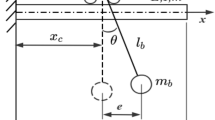Abstract
Because of its characteristics of high operating efficiency and low operating cost, jib crane, mainly used to complete the loading and unloading of cargo and stacking operations, has become indispensable transport equipment on ports and terminals. As the core structural component of jib crane, design of superstructure will affect the stability of machine directly. Based on the unified objective function method, the mathematical model about multi-objective optimal design of superstructure was established which superstructure was served as a whole. Reduction of the maximum of the luffing resistance moment and unbalanced torque, as well as decrease of the fluctuations of hanging point vertical displacement were taken as the objective functions, and the coordinate of the hinge point position, structure length and counterweight were regarded as the design variables. The mixed penalty function of MATLAB was used for the optimization calculation. At the same time, interface for optimization design of jib crane’s superstructure was developed with C # and MATLAB hybrid programming language at the platform of VS. This interface can achieve the visualization of optimal design process. The result after optimization indicates that fluctuations of hanging point vertical displacement, maximum of the luffing resistance moment, as well as unbalanced torque decreased. This means drive power was saved, which has important theoretical significance.














Similar content being viewed by others
References
Liu JB (2014) Structural optimization research on Jib system of Single-Jib portal crane. Shanghai Jiaotong University, Shagnhai, pp 20–30
Chen LY (2012) Structural optimization research on combined jib system of elastic four-bar linkage. Wuhan University of Technology Press, Wuhan, pp 15–35
Miao M, Qu FZ, Sun HW (1995) Optimization of luffing system about portal crane’s compensating pulley. J Dalian Univ Technol 12:853–856
Zhang H, Xu CS (2015) Structure optimization of crane boom based on MATLAB and parametric modeling. J Wuhan Univ Technol 2:201–205
Li MX (2006) Optimization design for portal crane luffing system based on genetic algorithms. Wuhan Univ Technol 5:1–20
Wang JB (2009) Researching for steel structure calculation system of four-bar-type gantry crane. Dalian Univ Technol 11:2–30
Terashima K, Shen Y, Yano K (2007) Modeling and optimal control of a rotary crane using the straight transfer transformation method. Control Eng Pract 15:1179–1192
Cai HN (2015) Research and application of penalty function method in constrained optimization. East China Norm Univ (Shanghai) 5:1–20
He D, He C, Jiang LG (2001) Optimized phase tracking method of chaotic spreading sequences based on mixed penalty function. J Shanghai Jiaotong Univ 11:1611–1614
Deb K (2001) Multi-objective optimization using evolutionary algorithms, vol 6. Wiley, Chichester, pp 30–35
Altintas Y, Cao Y (2005) Virtual design and optimization of machine tool spindles. Ann Manuf Technol 54(1):379–382
Gu MY (2011) Optimization research of articulated boom for TZG216-110-type iron roughneck. Lanzhou Univ Technol 5:1–50
Lu GX, Ni QX, Zhang RQ (1985) Portal crane. People’s Communications Press, Beijing, pp 84–230
Luo JM, An YZ, Zhang MS (2013) Optimization and force analysis of bar linkage hinge point of self erecting tower crane. Appl Mech Mater 13(5):150–161
Wang P, Zheng SL, Wu GQ (2011) Multidisciplinary design optimization of vehicle body structure based on collaborative optimization and multi-objective genetic algorithm. J Mech Eng 1:102–105
Gamino M, Pedraza JC, Ramos JM et al (2006) Matlab-C++ interface for a flexible arm manipulator simulation using multi-language techniques. In: Fifth Mexican international conference on Artificial intelligence, 2006. MICAI’06. IEEE, pp 369–378
Sastry K (2007) Single and multiobjective genetic algorithm toolbox for matlab in C++. IlliGAL Report, pp 201–208
Jiang YK, Liu GQ, Li Z (2013) Optimization of hinge position for working device of excavators by genetic algorithm. J Huazhong Univ Sci Technol 3:155–162
He QH, Wang SL, He JL (2014) Optimization of hinge point position of leveling mechanism for the telescopic handler. J Zhengzhou Univ Eng Sci 7:52–54
Acknowledgements
The paper is supported by National Natural Science Foundation of China (Grant Number: 51578140); the Fundamental Research Funds for the Central Universities, China (Grant Number: CXZZ12_0108).
Author information
Authors and Affiliations
Corresponding author
Additional information
Technical Editor: Aline Souza de Paula.
Rights and permissions
About this article
Cite this article
Li, S., Wan, CF. & Hou, Z. Structural optimization research on superstructure of jib crane. J Braz. Soc. Mech. Sci. Eng. 39, 2779–2787 (2017). https://doi.org/10.1007/s40430-017-0718-8
Received:
Accepted:
Published:
Issue Date:
DOI: https://doi.org/10.1007/s40430-017-0718-8



